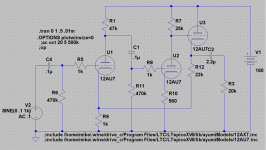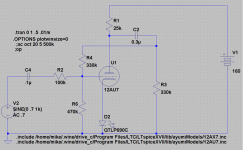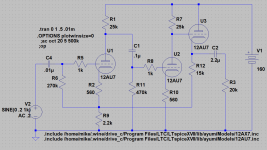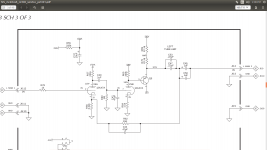I am looking for input on line stage feedback strategies. I see several options with various advantages and disadvantages but am always ready to learn of other options as well as opinions on best approaches.
1. Two stage with plate to cathode FB. The largish gain allows (or requires depending on your perspective) a large FB ratio. It has the advantage of preserving the high Zin but requires two active devices per channel.
2. Single stage plate to grid. Has the advantage of simplicity but requires some method of preserving Zin. A simple series input resistor does this of course with some reduction in sensitivity and slightly increased noise.
3. LTP with FB to inverting input. Potential reduction in even order distortion due to PP nature might be especially useful with the likes of 12AU7. Downside of 2 active devices and the fact that I have never been able to get a satisfactory result in simulation (prob due to my lack of clarity on the implementation.
4. Pentode with screen feedback. Open to input on pros and cons here. One would seem to be a limited range of FB ratios.
So what are your favorite flavors?
1. Two stage with plate to cathode FB. The largish gain allows (or requires depending on your perspective) a large FB ratio. It has the advantage of preserving the high Zin but requires two active devices per channel.
2. Single stage plate to grid. Has the advantage of simplicity but requires some method of preserving Zin. A simple series input resistor does this of course with some reduction in sensitivity and slightly increased noise.
3. LTP with FB to inverting input. Potential reduction in even order distortion due to PP nature might be especially useful with the likes of 12AU7. Downside of 2 active devices and the fact that I have never been able to get a satisfactory result in simulation (prob due to my lack of clarity on the implementation.
4. Pentode with screen feedback. Open to input on pros and cons here. One would seem to be a limited range of FB ratios.
So what are your favorite flavors?
What is your current gain, and what do you want it to be? If you need to reduce from something like 14 to 10, easy, just leave the cathode resistor unbypassed. If trying to go down from say, 14 to 3, then plate to grid works well enough, withough too much penalty in noise or input impedance.
Shows excellent distortion potential but still quite a lot of gain (17).
With an input coupling capacitor, you can add a new resistor R13 (chosen for biasing U1) between the U1 cathode and R9. Also return the U1 grid resistor R6 to the junction of R13 and R9. Then you can increase R9 (and reduce R12 if necessary) to reduce the gain. This also bootstraps R6, so input capacitor C4 can be smaller.
Last edited:
Something like this?
View attachment 681968
Shows excellent distortion potential but still quite a lot of gain (17). I was running the CF current through the bias resistor to avoid cap coupling the FB. Perhaps with the right R values I could snag it from the U2 anode instead of the follower output.
You need either feedback through a cap, or input cap and positive grid bias of the 1'St tube.
And, probably, some kind of HF compensation, if it starts oscillating.
For lower gain better use 1 stage with CF, with feedback to the 1'St grid after output coupling cap.
Ah yes (slaps forehead) much better.
Even better, with huge input impedance.
Even better, with huge input impedance.
I am not sure I understand. Are you saying this is good or suggesting a change.
I actually might have use for both. I have a SE UL KT-88 that sounds really nice but has low sensitivity. On the two stage I could have a switchable resistor parallel to the lower cathode resistor to allow high and low gain settings. Also the bootstrapped bias resistor should give adequate Zin for a ceramic cart and one could switch in a resistor to ground before the input cap for tape or CD. The single stage could make a nice simple utility pre.
(1) above.I am looking for input on line stage feedback strategies. I see several options with various advantages and disadvantages but am always ready to learn of other options as well as opinions on best approaches.
1. Two stage with plate to cathode FB. The largish gain allows (or requires depending on your perspective) a large FB ratio. It has the advantage of preserving the high Zin but requires two active devices per channel.
2. Single stage plate to grid. Has the advantage of simplicity but requires some method of preserving Zin. A simple series input resistor does this of course with some reduction in sensitivity and slightly increased noise.
3. LTP with FB to inverting input. Potential reduction in even order distortion due to PP nature might be especially useful with the likes of 12AU7. Downside of 2 active devices and the fact that I have never been able to get a satisfactory result in simulation (prob due to my lack of clarity on the implementation.
4. Pentode with screen feedback. Open to input on pros and cons here. One would seem to be a limited range of FB ratios.
So what are your favorite flavors?
I am not sure I understand. Are you saying this is good or suggesting a change.
High input impedance is a good thing. Easier for weak sources to drive easily.
High input impedance is a good thing. Easier for weak sources to drive easily.
Also the smaller input capacitor will sound better.
Also the smaller input capacitor will sound better.
Eh, not necessarily (or at least, not enough to matter)
If you're using capacitors large enough that they affect the sound that much, you should switch to a better capacitor type anyway.
Better yet is it takes less current to charge a smaller capacitor, and smaller caps are often more affordable and physically smaller for a given voltage for a given quality.
Ah yes (slaps forehead) much better.
Also, if building this, run a 6DJ8/6922 in the cathode follower position, it will give you very nice and low output impedance. That, or a mosfet
- Status
- This old topic is closed. If you want to reopen this topic, contact a moderator using the "Report Post" button.
- Home
- Amplifiers
- Tubes / Valves
- Line stage feedback strategies



